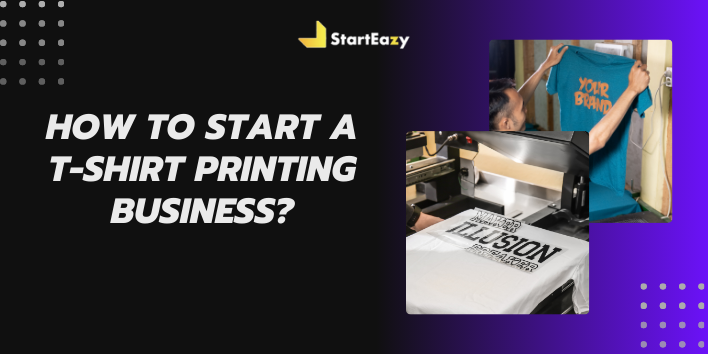How to Start a T-Shirt Printing Business | Steps and Licenses

Starting a T-shirt printing business can be a great opportunity to channel your creativity into a profitable venture. With the demand for custom clothing and personalized apparel increasing, now is a great time to step into this growing industry.
Whether you’re passionate about fashion or want to express creativity, a T-shirt printing business allows you to create unique products that resonate with different audiences.
Why Start a T-Shirt Printing Business?
Before diving into the practical steps, let's first consider why this business could be a good fit for you:
-
Creative Freedom: If you have a knack for design or unique ideas, a T-shirt printing business is a platform to express your creativity.
-
Growing Market: The demand for custom T-shirts for events, brands, and personal use is on the rise, making it a lucrative industry.
-
Low Initial Investment: With the option to start small and scale up, the financial barrier to entry is relatively low compared to other businesses.
-
E-commerce Growth: With the rise of online shopping, selling T-shirts through your own e-commerce site or marketplaces like Etsy or Amazon is easier than ever.
Here's a step-by-step guide to starting a T-shirt printing business, covering all the essentials, from licenses to equipment.
Step 1: Conduct Market Research and Define Your Niche
Step 2: Develop Unique and Marketable Designs
Step 3: Choose the Right Printing Method
Step 4: Source High-Quality Materials and Suppliers
Step 5: Set Up Your Business Legally
Step 6: Purchase Equipment and Set Up Your Workspace
Step 7: Set Competitive Pricing
Step 8: Build an Online Presence
Step 9: Market and Promote Your Business
Step 1: Conduct Market Research and Define Your Niche
Before you dive into launching your T-shirt business, laying a solid foundation through thorough market research is crucial.
This research will guide your business decisions, from product design and pricing to marketing strategies, ensuring that your brand resonates with your target audience.
Understand Your Audience:
Start by identifying who you’re creating T-shirts for.
Is your focus on young trendsetters, fitness enthusiasts, or working professionals?
Perhaps your goal is to cater to businesses needing bulk orders for promotional events, branded merchandise, or team-building activities.
The more you understand your target demographic, the better you can cater to their specific tastes and needs.
Analyze Market Trends:
Keep a close eye on what’s trending in the industry.
Platforms like Instagram, Etsy, Pinterest, and Google Trends are goldmines for seeing which designs, patterns, and styles are gaining traction.
Study successful competitors and take note of both their strengths and gaps in the market.
What are they offering?
What’s missing that you could provide?
Analyzing this data will help shape your unique value proposition.
Narrow Down Your Niche:
Finding a specific niche can set your brand apart. Instead of trying to cater to everyone, focus on a particular theme or style that aligns with your target audience.
This could include eco-friendly, sustainable T-shirts, shirts featuring motivational quotes, or niche themes like pop culture, sports teams, or local pride.
A well-defined niche will help attract a loyal and engaged customer base.
Step 2: Develop Unique and Marketable Designs
The success of your T-shirt printing business will largely depend on the uniqueness and appeal of your designs.
Well-thought-out and attractive designs will draw customers to your brand.
-
Create Designs Yourself or Hire Designers: If you have graphic design skills, tools like Adobe Illustrator, Photoshop, or Canva can be great for creating designs. If not, you can hire freelance designers from platforms like Fiverr, Upwork, or 99designs to bring your ideas to life.
-
Test Your Ideas: Before printing a large batch, get feedback on your designs. Share them with friends, family, or social media followers to gauge their interest and gather suggestions for improvements.
-
Consider Licensing: If you plan to use copyrighted elements, such as a character from a popular TV show or movie, make sure you obtain the necessary licensing rights. This will prevent potential legal issues.
Your designs should not only resonate with your audience but also reflect your brand’s identity. A well-defined design strategy will attract customers and differentiate you from competitors.
Step 3: Choose the Right Printing Method
Choosing the right printing method is critical because it affects the quality, speed, and cost of production.
Each method has its pros and cons depending on your budget, volume, and design complexity.
-
Screen Printing: Ideal for bulk orders, screen printing involves creating stencils for each color in the design and applying ink through screens. This method produces vibrant, durable designs but may not be cost-effective for smaller batches or complex, multi-color designs.
-
Direct-to-Garment (DTG) Printing: DTG uses a specialized printer to apply ink directly to the fabric, making it suitable for highly detailed and colorful designs. It is great for small batches or on-demand orders but can be slower and more expensive per unit.
-
Heat Transfer: This method uses heat to transfer designs from vinyl or transfer paper onto the fabric. It’s good for small quantities or simple designs, but the prints may not last as long as those produced by other methods.
-
Sublimation: Sublimation printing is ideal for polyester fabrics and produces durable, high-quality prints that are embedded into the fabric. However, it is not suitable for cotton.
Each method has different costs, durability levels, and design flexibility, so choose the one that aligns best with your business model and design needs.
Key Factors for Choosing the Best Printing Method
|
Factor |
Screen Printing |
Direct-to-Garment (DTG) |
Heat Transfer |
Sublimation |
|
Order Volume |
Best for large batches |
Suitable for small batches |
Good for small orders |
Best for small to medium batches |
|
Design Complexity |
Simple designs with few colors |
Great for detailed, colorful designs |
Suitable for simple designs |
Excellent for complex, full-color designs |
|
Fabric Type |
Best for cotton and natural fabrics |
Ideal for cotton and other fabrics |
Works on various fabric types |
Best for polyester and synthetic fabrics |
|
Durability |
Highly durable |
Durable, but less than screen printing |
Moderate durability |
Extremely durable, long-lasting |
|
Cost |
Cost-effective for large orders |
Higher cost per unit for small orders |
Low setup cost, higher cost per unit |
Moderate to high cost for small batches |
|
Turnaround Time |
Longer setup, fast for large orders |
Slower for individual orders |
Fast for small quantities |
Medium, depending on batch size |
|
Environmental Impact |
Traditional methods use chemical-based inks |
Uses water-based inks (more eco-friendly options) |
Vinyl and paper transfers have some waste |
Water-based inks, lower environmental impact |
Step 4: Source High-Quality Materials and Suppliers
The quality of the T-shirts you offer is just as important as the design.
Poor-quality materials can lead to dissatisfied customers and high return rates, so it’s crucial to source reliable suppliers.
-
Select the Fabric Type: T-shirts are typically made from cotton, polyester, or blends. Cotton is breathable and comfortable, making it a popular choice, but polyester is more durable and moisture-resistant, ideal for athletic or performance wear. Cotton-polyester blends provide a balance between the two.
-
Find Reliable Suppliers: You can find suppliers locally or through online platforms like Indiamart, Alibaba, or TradeIndia. When choosing a supplier, ensure they provide consistent quality, offer competitive prices, and have a good reputation for timely deliveries.
-
Order Samples: Before committing to bulk purchases, request fabric and T-shirt samples from your suppliers. Test them for comfort, shrinkage, color retention, and how well they take to printing.
Investing in high-quality T-shirts ensures that your customers receive durable, comfortable products, which will help build trust and encourage repeat business.
Step 5: Set Up Your Business Legally
Setting up your t-shirt printing business legally is crucial for long-term success, and we’re here to help you through every step of the process. Follow these simple steps for company registration online and stay compliant with the business laws:
-
Get in Touch with Our Experts at StartEazy:
Begin by filling out the form on the right, and our experts will guide you through the entire process.
-
Choose Your Business Structure:
Based on your needs and goals, decide whether you want to register as a sole proprietorship, partnership, or private limited company. Our team will help you choose the best option for you.
-
Share the Required Documents:
Once you've chosen your business structure, provide the necessary documents. Our experts will ensure everything is in order for smooth processing.
-
Our Experts Will Register Your Business:
Leave the rest to us! We’ll handle the registration process, making sure your business is legally recognized and compliant.
Obtain a GST Number
After registering your business with the appropriate authorities, it is crucial to secure a GST number to handle tax compliance. Depending on your location, you may also need a local trade license or other permits specific to your state or city regulations. Make sure to research all the legalities or hire an expert for a smooth GST registration process.
Trademark Your Designs and Logo:
If your t-shirt designs or logos are unique, safeguarding your intellectual property is vital. File for a trademark to legally protect your creations, ensuring no one can replicate or sell your designs without permission. This adds a layer of protection to your brand as it grows and ensures you maintain ownership over your creative work.
Step 6: Purchase Equipment and Set Up Your Workspace
Once your business is legally registered, the next step is to invest in the necessary equipment for printing T-shirts.
Printing Equipment:
Depending on your chosen printing method (screen printing, DTG, etc.), invest in a high-quality heat press machine, transfer paper, or printers. The initial investment may be significant, but good equipment ensures professional-quality prints and efficient production.
Workspace:
Set up a workspace where you can store your materials, work on designs, and complete printing orders. Make sure your workspace is organized, ventilated (if using inks), and has enough room to manage multiple orders if necessary.
Software:
Use design and accounting software to manage your business. For design, Adobe Creative Suite is popular, while QuickBooks or Zoho Books can help you keep track of finances.
Having the right equipment and a productive workspace will help streamline your operations and enable you to meet customer demands efficiently.
Step 7: Set Competitive Pricing
Pricing your products correctly is essential for staying competitive while maintaining profitability.
-
Calculate Costs: Factor in the cost of T-shirts, printing, shipping, and other overheads (rent, utilities, website maintenance). Include any labor costs if you have employees or freelancers.
-
Determine Profit Margins: Once you have calculated your production costs, decide on your profit margins. A common margin for custom T-shirt businesses is around 30% to 50%, but this may vary based on your market.
-
Research Competitors: Look at the prices of similar products offered by your competitors. Your pricing should align with the quality of your products, but make sure to stay competitive, especially if you are targeting a specific niche.
Setting competitive prices will attract customers while ensuring that you cover costs and generate profit.
Step 8: Build an Online Presence
In today’s digital landscape, establishing a robust online presence is essential for expanding your reach and boosting sales.
Here’s how you can effectively build and enhance your online presence:
Create a Professional E-commerce Website
Opt for user-friendly ecommerce platforms like Shopify, WooCommerce, or Wix that offer customizable templates and built-in features.
Ensure your website highlights your T-shirt designs with high-quality images and compelling descriptions. A clean, intuitive design will help customers navigate easily and make purchases effortlessly.
Integrate secure payment gateways such as Stripe, PayPal, or local payment options to build trust and ensure a smooth checkout process.
Establish and Optimize Social Media Profiles:
Focus on visually driven platforms like Instagram, Facebook, and Pinterest where you can showcase your T-shirt designs effectively.
Share high-quality images, behind-the-scenes looks, customer testimonials, and interactive posts. Utilize stories, reels, and live sessions to connect with your audience.
Run targeted ad campaigns to reach specific demographics, promote new designs, and drive traffic to your website.
Enhance Customer Experience:
-
Responsive Design: Ensure your website is mobile-friendly, providing a seamless experience across all devices.
-
Customer Support: Implement live chat or customer support features to address queries and assist with any issues promptly.
-
Feedback Mechanism: Encourage and respond to customer feedback to continually improve your services and products.
Ensure to create a solid online presence, you’ll increase your chances of attracting a larger customer base and growing your business.
Step 9: Market and Promote Your Business
To generate sales, you’ll need to market your T-shirt printing business effectively. For this purpose you can do the following:
-
Leverage Social Media Marketing: Post regularly on social platforms, showcasing new designs, behind-the-scenes content, and customer testimonials. You can also run paid ads on platforms like Facebook or Instagram to target specific demographics.
-
Collaborate with Influencers: Partner with influencers who align with your brand. They can help promote your products to their followers and generate buzz around your designs.
-
Email Marketing: Build an email list and send regular newsletters with updates, special promotions, and new product releases. Email marketing is a cost-effective way to engage with your customers.
-
Attend Events and Trade Shows: Participate in local markets, pop-up shops, or online marketplaces to increase your brand visibility.
A solid marketing strategy will help you generate sales and grow your customer base effectively.
Conclusion
Starting a T-shirt printing business is a rewarding venture with low barriers to entry. By following these steps—conducting market research, developing designs, investing in the right equipment, and setting competitive prices—you’ll be well on your way to building a successful brand. With the right approach and commitment, your T-shirt printing business can grow steadily and become profitable in a thriving market.








